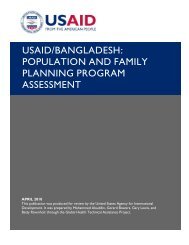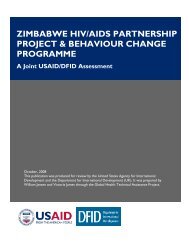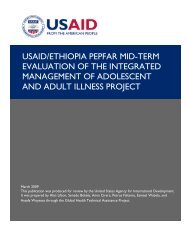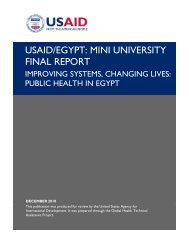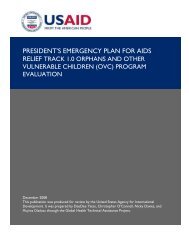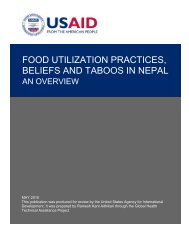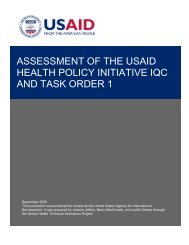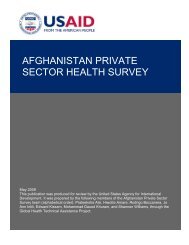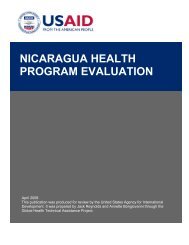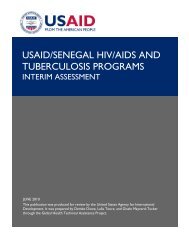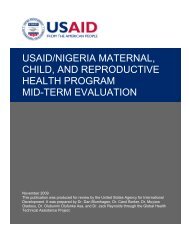Evaluation of the Tuberculosis Control Assistance Program (TB CAP)
Evaluation of the Tuberculosis Control Assistance Program (TB CAP)
Evaluation of the Tuberculosis Control Assistance Program (TB CAP)
Create successful ePaper yourself
Turn your PDF publications into a flip-book with our unique Google optimized e-Paper software.
<strong>TB</strong> <strong>CAP</strong> is a highly successful project that has had significant impact, is well-managed, and is achievingits goals. Given <strong>the</strong> progress <strong>TB</strong> <strong>CAP</strong> has made in some countries to improve conditions for <strong>TB</strong> controlprograms worldwide, <strong>the</strong> evaluation team strongly recommends that USAID continue and expand itssupport for it.Although <strong>TB</strong> <strong>CAP</strong> has effectively achieved many <strong>of</strong> its project expectations, USAID has a moreambitious goal: If USAID is ―to contribute significantly to <strong>the</strong> global reduction <strong>of</strong> morbidity and mortalityassociated with tuberculosis,‖ 2 as it desires, it should take a more long-range and ambitious approach to<strong>the</strong> TA it provides. Certainly <strong>the</strong> <strong>TB</strong> <strong>CAP</strong> project has demonstrated sound strategic principles that shouldbe even more rigorously embedded in future USAID support for TA, notably <strong>the</strong> <strong>TB</strong> <strong>CAP</strong> emphasis onenhancing <strong>the</strong> institutional and managerial capacity <strong>of</strong> national systems <strong>of</strong> <strong>TB</strong> controlsupporting a variety <strong>of</strong> technical areas, with a focus on ensuring that <strong>the</strong> fundamental building blocks<strong>of</strong> an effective <strong>TB</strong> control program are in place, especially effective drug management and sufficientcapacity and coordination <strong>of</strong> laboratory networksstreng<strong>the</strong>ning and integrating directly observed treatment (DOTS) systems between governmen<strong>the</strong>alth facilities and nongovernmental institutions and providers, such as community-based volunteerscustomizing support to align it with each country’s state <strong>of</strong> development and national <strong>TB</strong> controlstrategy and priorities, policies, and technical guidelines.To realize its overarching goals USAID should shift its focus from short-term, high-yield activitiestoward longer-term, country-wide activities that convert <strong>the</strong> experiences <strong>of</strong> <strong>TB</strong> <strong>CAP</strong> for greater nationaland global impact. This would not require wholesale refashioning <strong>of</strong> <strong>the</strong> current <strong>TB</strong> <strong>CAP</strong> model, but itwould require more closely aligning some <strong>of</strong> its elements:USAID should encourage its Missions to develop multiyear workplans for <strong>TB</strong> control, linked tonational strategies and plans, and formally support <strong>the</strong>ir approval, while providing for annualadjustments and resourcing based on needs, progress made, and availability <strong>of</strong> funds. Longer-termplanning would make country <strong>TB</strong> control measures more sound and help stimulate investment intechnical capacity to meet demand.The future implementing mechanism should include a governing board to deal with issues <strong>of</strong>governance, program strategy, and budgeting, mandated to develop and implement a strategic agendafor scale-up <strong>of</strong> support to countries. Medium- and long-term strategic oversight is essential to ensure<strong>the</strong> best possible support to countries, maximum benefits to <strong>the</strong> global community, and efficient andresponsible use <strong>of</strong> USAID funding.The administrative arm should be empowered within <strong>the</strong> sphere <strong>of</strong> its responsibility to makemanagement decisions—seeking USAID or board-level approval when necessary and operatingefficiently and transparently.USAID should also consider improving <strong>the</strong> <strong>TB</strong> <strong>CAP</strong> model, which has already demonstrated itseffectiveness, to assure <strong>the</strong> quality <strong>of</strong> <strong>TB</strong> control measures in health facilities, promote timelier financialforecasting and reporting by implementing agencies, and adopt more effective approaches to collecting,analyzing, and sharing experiences. To accomplish overarching USAID goals, this mission should bereset at an even higher level and structured to achieve it.2 US Agency for International Development: Expanded Response to <strong>Tuberculosis</strong>, January 2009.viiiEVALUATION OF THE TUBERCULOSIS CONTROL ASSISTANCE PROGRAM (<strong>TB</strong> <strong>CAP</strong>)



